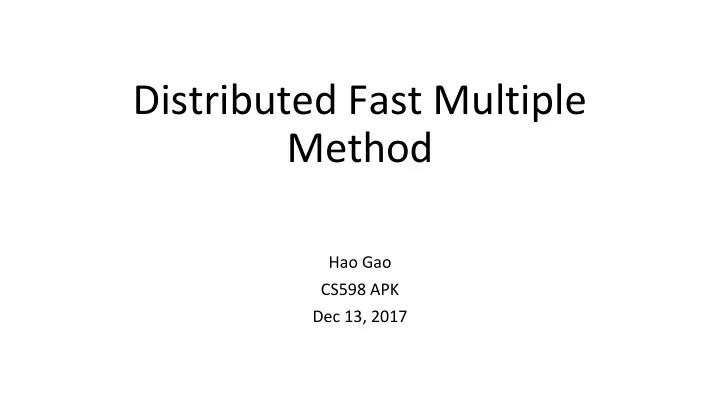

Distributed Fast Multiple Method Hao Gao CS598 APK Dec 13, 2017
Why FMM? Direct Evaluation – O(MN) – too costly for large problem FMM solves this problem in linear time - O(M+N) In this class, used to evaluate layer potentials
Idea: Local and Multipole Expansion Local Expansion Multipole Expansion Figure Credit: A. Kloeckner
FMM Overview (1) Build the tree and interaction lists (2) Calculate multipole densities in the leaf boxes (3) Upward propagation (M2M) (4) List 1, U: Direct evaluation (5) List 2, V: Multipole to local (6) List 3, W: Multipole to point (7) List 4, X: Point to local (8) Downward propagation (9) Evaluate local expansion at targets Figure Credit: I. Lashuk, et al.
How our FMM is different Target particles may have scales: • particles on internal nodes • direct evaluation for some particles on list 3 and 4
Plan of this project Already have a shared-memory parallel implementation Time needed to evaluate point potentials of 300,000 sources and 300,000 targets in 2 dimensions, with highest expansion order 3: Step Time Generate Tree 1.45s Generate Interaction Lists 1.13s Shared-memory FMM Evaluation (using OpenMP) 13.74s
Distributed FMM Overview
What particles to distribute, and how? • 5 x 7 3 6 x 4 x x 1 1 0 1 1 1 0 1 0 0 1 0 1 1 2 3 4 4 5 5 5 5 7 3 6 4 1
Load Balancing • First try: Divide all boxes evenly • Second try: Divide all particles evenly • Current scheme: use DFS (Morton) order, divide the workload evenly FMM in 1 thread 51.88s process 1 of 8 5.32s process 2 of 8 5.85s process 3 of 8 5.86s process 4 of 8 5.97s process 5 of 8 6.69s process 6 of 8 6.65s process 7 of 8 7.47s process 8 of 8 7.80s
Morton (DFS) ordering Figure Credit: M. Warren & J. Salmon
Communication in upward propagation •
Future plan • Reorder the box to save particle scan • Integrate with layer potential evaluation • Test scalability on large scale of processors • Overlap communication and computation Reference Lashuk, I., Chandramowlishwaran, A., Langston, H., Nguyen, T. A., Sampath, R., Shringarpure, A., ... & Biros, G. (2012). A massively parallel adaptive fast multipole method on heterogeneous architectures. Communications of the ACM , 55 (5), 101-109. Warren, M. S., & Salmon, J. K. (1993, December). A parallel hashed oct-tree n-body algorithm. In Proceedings of the 1993 ACM/IEEE conference on Supercomputing (pp. 12-21). ACM.
Recommend
More recommend